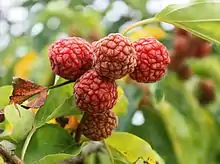Maclura tricuspidata
Maclura tricuspidata is a tree native to East Asia, occasionally grown for its fruit, somewhat similar to that of the related mulberry (Morus spp.). It is also known by common names including cudrang, kujibbong, mandarin melon berry, silkworm thorn, zhe or che (Chinese: 柘; pinyin: zhè), and Chinese mulberry (but not to be confused with Morus australis also known by that name). It grows up to 6 m high.
| Maclura tricuspidata | |
|---|---|
 | |
| Scientific classification | |
| Kingdom: | Plantae |
| Clade: | Tracheophytes |
| Clade: | Angiosperms |
| Clade: | Eudicots |
| Clade: | Rosids |
| Order: | Rosales |
| Family: | Moraceae |
| Genus: | Maclura |
| Species: | M. tricuspidata |
| Binomial name | |
| Maclura tricuspidata (Carrière) Bureau | |
| Synonyms | |
|
Cudrania tricuspidata Carrière | |
The Tanzhe Temple west of Beijing, China is named for this tree.
Fossil record
Fossils similar to Maclura tricuspidata have been collected from the Eocene of France, Miocene of Bulgaria, Pliocene of China and Quaternary of Japan.[1]
References
- Martinez Cabrera HI, Cevallos-Ferriz SRS (2006). "Maclura (Moraceae) wood from the Miocene of the Baja California Peninsula, Mexico: Fossil and biogeographic history of its closer allies". Review of Palaeobotany and Palynology. 140: 113–122. doi:10.1016/j.revpalbo.2006.03.004.CS1 maint: uses authors parameter (link)
External links
- California Rare Fruit Growers (with fruit photo)
- Nanjing University Plant Resources Network (in Chinese, with photo)
- Plants for a Future database
This article is issued from Wikipedia. The text is licensed under Creative Commons - Attribution - Sharealike. Additional terms may apply for the media files.
